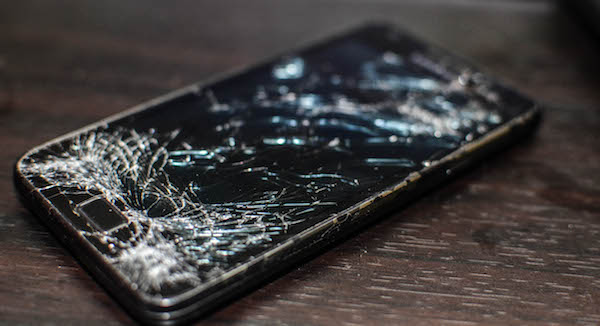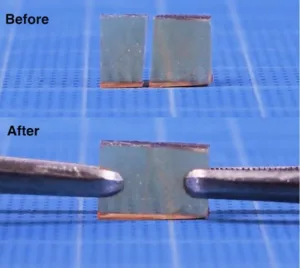After a week of CES bombardment with the newest and finest consumer electronics products we have thought up last year, I want to entertain you with the headline of CES 2037 (plus minus a few decades) – NO MORE BROKEN PHONES!

As many of you have already experienced, a perfectly good day can be severely hampered by dropping the smartphone of your choice on a hard surface. This happens regardless of the brand of your phone, no matter what the respective marketing divisions would like you to believe. In addition, this also seems to happen more frequently when you are under some kind of stress and/or a deadline, which is nothing but the mobile device implementation of Murphy’s law.
 Shattered Screen – credits Wikimedia.org
Shattered Screen – credits Wikimedia.org
As a consequence we typically try to dust off some glass splinters and, against all our parents’ hope in us listening to their good advice to not touch broken glass, we will definitely run our fingers over the shattered surface in hope that by some good fortune the touch screen is still working and we can go on with the day as planned. Ultimately, we have to bite the bullet and invest in a new display or a new phone, depending on how long it is to the release of the next ‘absolutely shatterproof’ phone.
Honestly, who hasn’t experienced this or a similar situation and is still hoping that one of these days one of the ‘shatterproof’ announcements are actually true.? So far I see three approaches (plus an alternative) to this promise that I want to discuss:
- Micro Display Screens
- Flexible OLED Displays
- Self Healing Materials
- Alternative Solution
Why Micro Displays may solve the issue to breaking phones
When we think about broken display screens, the issue is the brittleness of the display substrates. This goes back to the how we make displays and what a glass substrate provides to the display. Thinking of LCDs we use the glass substrate to create the thin film transistors directly on the glass. Since this happens at elevated temperatures the thermal expansion of the glass has to match that of the deposited Si-film to avoid any delamination. At the same time, the substrate has to be able to withstand high temperature for the Si-film deposition. These are not so good requirements to be fulfilled by plastic substrates.
There are processes to transport the TFT backplane from a dedicated carrier plate to another substrates, however these processes are used for micro displays and add a complication that will lead to higher manufacturing cost.
Promise: If we can create cost competitive micro displays, we can put them theoretically on all kinds of substrates including steel (would not be the first use of steel), covering them with a soft plastic will avoid all breakage.
Issues: So far we have no way to make cost competitive micro displays, with some major players even side stepping this technology for small high resolution display at the moment. Using a soft plastic on top may create more scratch sensitivity than we would like. Add another decade to make that unbreakable phone scratch resistant.
Flexible OLED will be Basically Break-Resistant
Most companies are working today on flexible OLED displays, which would make the device basically shatterproof. While dropping the display will not result in a shattered phone display as the substrates are flexible by definition, this may not mean the display still works. So far all connections are pretty rigid and damage to the connectors or the motherboard may result in good looking but not functioning display anyway.
Promise: Flexible substrates will absorb the energy from dropping the phone without destroying the display, resulting in a shatterproof phone.
Issues: Flexible substrates are thin plastic films that are by definition pretty sensitive to scratching. Hard film coatings may help but may also be more sensitive to cracking upon dropping. In addition a flexible display panel does not make the rest of the phone flexible. So far approaches to make a flexible phone are pretty rudimentary.
Self Healing Material Crack and Repair Themselves
This idea has existed as long as I can think back, to my early years of working for a glass company. Once we have a self repairing material, we don’t need glass anymore. All glass plants will be closed and we save a ton of energy by making this wonder material. Of course this wonder material still does not exist, even though scientists are still working on it.
In a recent publication by Yu Yanagisawa et. al. from Japan we see how far this idea has come in the last thirty years. The article “Mechanically robust, readily repairable polymers via tailored noncovalent cross-linking” shows a material that after it breaks can be pressed together at room temperature and become one piece again.
Self Healing Polymer Credit: Yu Yanagisawa et. al.
While this is an incredible result by any criteria, do you see how far this solution is away form being a solution for a shatterproof phone? Besides the color and the less than optimal clarity of the material, the broken parts come back together alright but leave a visible strain in the material. Also, if you think of a shattered phone screen, how long do you think you need to put all these shards back together? And to be clear, one wrong placement will basically make the whole thing useless.
Promise: Self healing materials may shatter but can be easily put together again.
Issues: Self healing materials are an interesting field for chemists around the globe, with no practical application in sight so far. Maybe by 2037 as promised, but not today or in five years from now. Keep watching science fiction movies to keep your dreams alive.
Alternative Solution
Let’s talk about the real solution to make a shatterproof phone – Don’t make a phone at all! As long as we have the smartphone form factor with designers making them thinner and larger at the same time, we will experience breakage to a certain degree, no matter how much bending strength Corning and their competitors are able to put into such glass substrates. In the scenario of display glass screen versus rock, statistics are just on the side of the rock.
When will we develop a new form factor to take the place of the current smartphone? Maybe it is AR/VR headset or a wearable display on the arm including the CPU implant. Who knows, but if I have to bet on a shatterproof smartphone, my money is on alternative form factors. Of course this opens up the discussion of the shatterproof headset, etc., but i will leave that to some else to discuss. NH

